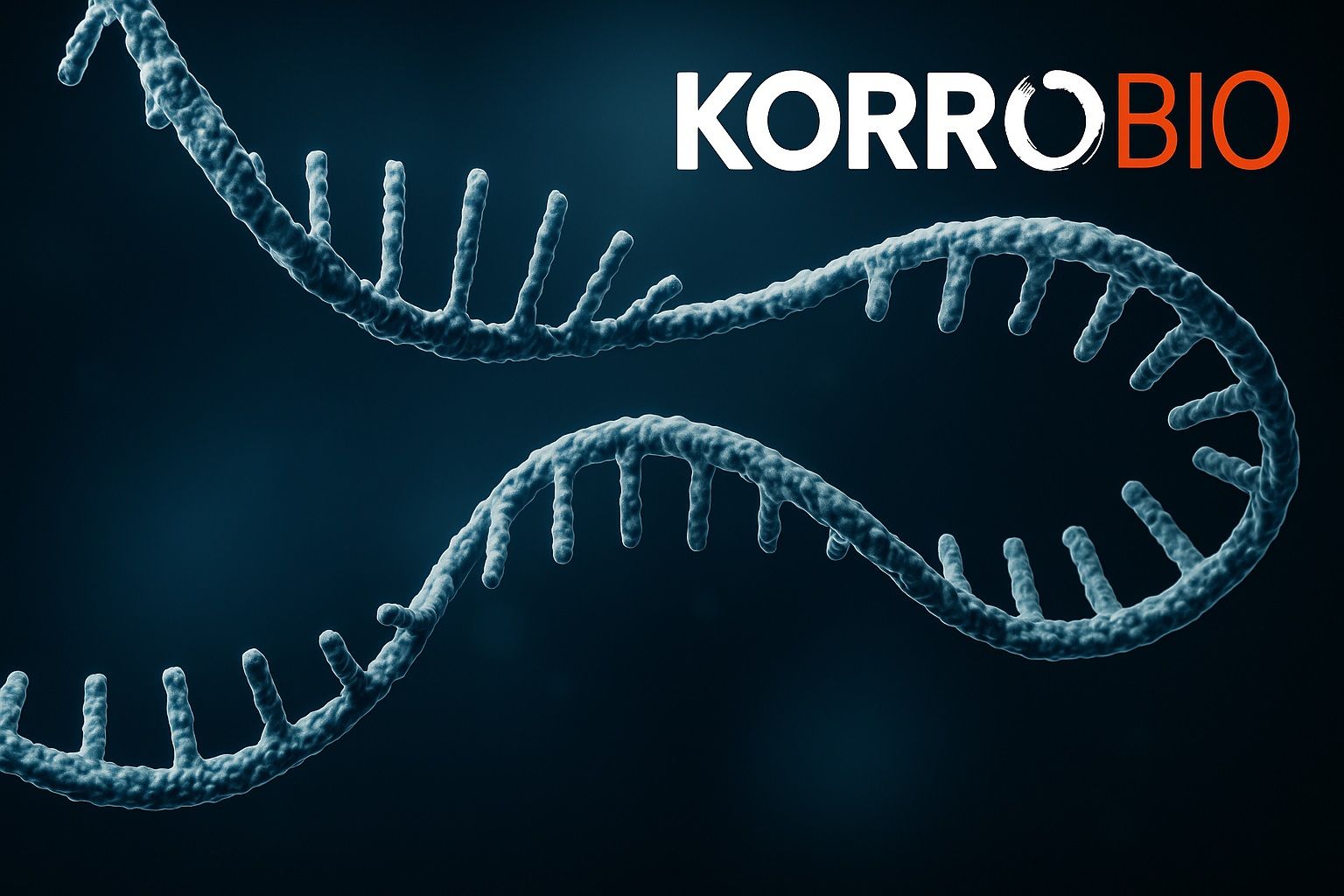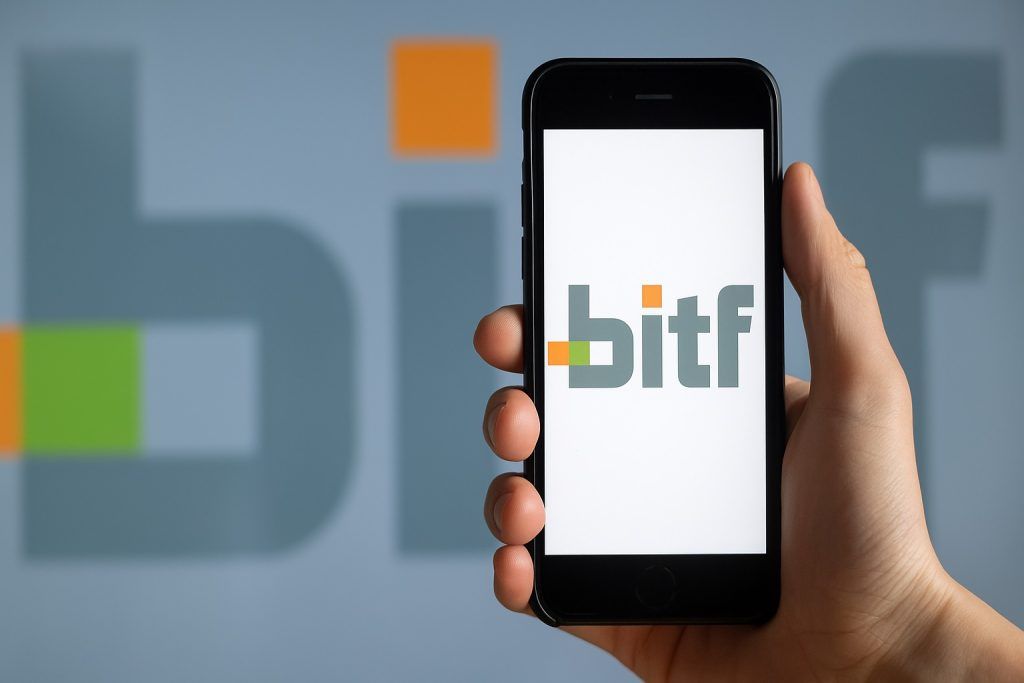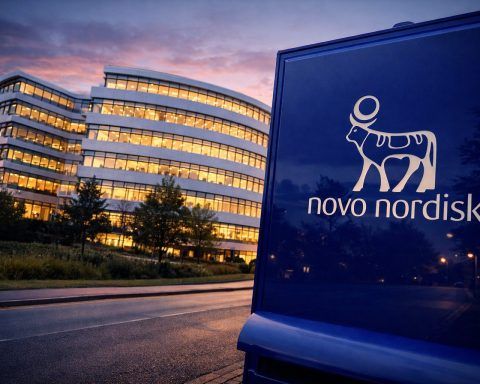Korro Bio, Inc. (NASDAQ: KRRO) is at the center of one of biotech’s biggest shake‑ups of 2025. After releasing mixed early data from its lead RNA‑editing program, KRRO‑110, the company has announced deep layoffs, a strategic pivot in its pipeline and a 12‑month pause in its high‑profile collaboration with Novo Nordisk. The stock has responded with a brutal collapse.
As of Thursday, 13 November 2025, here’s a full rundown of everything that has hit the tape around Korro Bio today and what it could mean for KRRO shareholders.
KRRO stock: from low‑30s to single digits in a day
Korro Bio closed regular trading on Wednesday, 12 November, at $31.42 per share, with a market cap just over $300 million. [1]
After the company reported third‑quarter 2025 results, disclosed underwhelming Phase 1/2a data for KRRO‑110 in alpha‑1 antitrypsin deficiency (AATD), and unveiled major restructuring moves, the stock plunged more than 75% in after‑hours and pre‑market trading, trading in the $7–$8 range, with some reports citing a pre‑market move of around $6.55–$6.60 per share (roughly a 79% drop). [2]
The dramatic repricing reflects investor concerns that:
- The lead asset KRRO‑110 may not be commercially competitive,
- The Novo Nordisk partnership is on ice for at least a year, and
- Korro is now effectively resetting as a pre‑clinical story centered around its next candidate, KRRO‑121. [3]
KRRO‑110: proof of RNA editing, but below therapeutic protein levels
KRRO‑110 is Korro’s first clinical‑stage RNA‑editing oligonucleotide, delivered via lipid nanoparticle (LNP) and designed to treat alpha‑1 antitrypsin deficiency (AATD) by correcting the SERPINA1 mutation and restoring normal M‑AAT protein. [4]
In the REWRITE Phase 1/2a trial, Korro reported:
- Safety: No dose‑limiting toxicities or treatment‑emergent serious adverse events. Infusion‑related reactions were mostly mild or moderate and resolved within 24 hours with standard medications. [5]
- Pharmacodynamics:
- Across five AATD patients in single‑ascending dose (SAD) cohorts, peak total AAT protein reached around 10 μM, with an approximate 3 μM increase from baseline, below the ~11 μM “protective” threshold many clinicians reference. [6]
- In three patients at the 0.8 mg/kg dose, functional M‑AAT protein was detected, with increases of about 2 μM and durability up to four weeks in the first evaluable patient. [7]
- Specificity: No evidence of unwanted “bystander” editing was observed in the LC/MS analysis. [8]
Analysts acknowledged that KRRO‑110 demonstrates human proof‑of‑concept for ADAR‑mediated RNA editing, but several research desks described the pharmacodynamic effect as modest and insufficient to justify a competitive AATD therapy at this stage. [9]
The data also revealed pharmacokinetic differences between healthy volunteers and AATD patients, suggesting that the LNP formulation behaves differently in the target population than in earlier studies. [10]
Strategic pivot: KRRO‑121 becomes the new lead, AATD moves to GalNAc
Faced with these mixed data, Korro is executing a major pipeline pivot:
- AATD program: The company is abandoning the current LNP‑delivered KRRO‑110 construct and pivoting the AATD effort to a GalNAc‑conjugated oligonucleotide, with a new development candidate expected in the first half of 2026 and a clinical start around 2027. [11]
- New lead asset – KRRO‑121:
- KRRO‑121 is a GalNAc‑conjugated RNA‑editing candidate targeting hyperammonemia, including patients with urea cycle disorders (UCD) and hepatic encephalopathy (HE). [12]
- It is designed to stabilize a key enzyme involved in ammonia clearance and to treat all UCD patients regardless of mutational background, while potentially reducing hyperammonemic crises in HE. [13]
- Korro expects to submit regulatory filings to begin first‑in‑human trials in the second half of 2026. [14]
In effect, KRRO‑121 is now described by several analysts as the primary value driver for the company, with the AATD program reset and further out on timelines. [15]
Novo Nordisk collaboration: 12‑month pause to reassess target
One of the most important headlines today is the decision by Korro and Novo Nordisk to amend their research collaboration and license agreement:
- The amendment implements a 12‑month pause on work under the first research program to reassess the scientific rationale for the current target. [16]
- Novo had previously committed up to $530 million in potential milestones and paid $10 million in upfront/early payments around the first program. [17]
- Under the pause, Korro will wind down R&D activities related to the paused program while both parties revisit the strategy. [18]
MarketWatch and other outlets flagged the pause of the Novo Nordisk collaboration as a key factor in the share price collapse, since the partnership was an external validation of Korro’s platform and an important potential revenue stream. [19]
34% workforce reduction and CMO resignation extend cash runway into 2027
To match its new, slimmed‑down pipeline, Korro is cutting approximately 34% of its workforce across all levels of the organization. [20]
Key restructuring details:
- The layoffs are expected to extend Korro’s cash runway into the second half of 2027, giving management time to generate clinical data for KRRO‑121 and at least one additional GalNAc program. [21]
- The company expects one‑time restructuring charges of about $2.4 million, mostly in Q4 2025. [22]
- Korro also disclosed the resignation of Chief Medical Officer Dr. Kemi Olugemo, effective 12 November 2025. [23]
This latest cut follows an earlier ~20% workforce reduction in May 2025, underlining how aggressively the company is now restructuring around its highest‑conviction programs. [24]
Q3 2025 financials: smaller loss, still a cash‑burn story
Alongside the clinical and strategic updates, Korro reported third‑quarter 2025 financial results:
- Cash, cash equivalents and marketable securities:
- $102.5 million as of 30 September 2025, down from $163.1 million at year‑end 2024. [25]
- Collaboration revenue:
- $1.1 million in Q3 2025, versus zero in Q3 2024, driven by Novo Nordisk collaboration revenue. [26]
- R&D expenses:
- $13.8 million, down from $16.0 million in the prior‑year quarter, largely due to lower KRRO‑110 and early‑stage research spend. [27]
- G&A expenses:
- $6.5 million, down from $7.3 million a year earlier, aided by lower professional services costs. [28]
- Net loss:
- $18.1 million, an improvement versus $21.0 million in Q3 2024. [29]
Analyst commentary still characterizes Korro as rapidly burning cash, despite its strong current ratio and extended runway. [30]
Wall Street reaction: ratings slashed, price targets cut from $25–$93 to ~$7–$8
Today has brought a wave of analyst downgrades, most of them landing on 13 November 2025:
- RBC Capital
- Rating cut from Outperform to Sector Perform.
- Price target slashed to $8 from $85.
- Notes that while KRRO‑110 was well tolerated, the effect on AAT protein levels was “modest” and below the protective 11 μM threshold. [31]
- Clear Street
- Rating cut from Buy to Hold.
- Price target cut to $7 from $93 after KRRO‑110 failed to achieve expected editing levels; calls the setback a major blow in what was viewed as a potential “three‑horse race” with Wave and Beam. [32]
- Chardan Capital Markets
- Rating cut from Buy to Neutral.
- Price target reduced to $7 from $25, noting that single‑dose KRRO‑110 failed to generate meaningful AAT protein in AATD patients and never reached the 11 μM threshold. [33]
- Cantor Fitzgerald
- Rating cut from Overweight to Neutral following “failure” of the lead AATD asset.
- Highlights the 34% workforce reduction and 12‑month pause of the Novo collaboration, but argues the issue may be specific to KRRO‑110 rather than the entire ADAR platform. [34]
- Raymond James
- Rating cut from Outperform to Market Perform.
- Emphasizes the failure to raise total AAT above ~11 μM, and increased uncertainty over whether the problem stems from LNP formulation, oligo design or manufacturing. [35]
- H.C. Wainwright
- Rating cut from Buy to Neutral, citing KRRO‑110’s below‑target M‑AAT increases (~2 μM) and pivot to new AATD construct. [36]
- William Blair
- Rating cut from Outperform to Market Perform.
- Calls the REWRITE outcome a “large blow,” says KRRO‑110 currently looks non‑competitive, and warns that Korro is now “well behind” rivals using GalNAc delivery. [37]
Collectively, the Street has moved from seeing KRRO as a high‑conviction RNA‑editing growth story to a show‑me story with single‑digit price targets and a long road to the next clear catalyst.
How the market is framing Korro Bio today
Putting today’s news together, investors appear to be digesting several competing ideas:
1. Platform validated, lead asset impaired
On the positive side:
- KRRO‑110 did edit human RNA in patients, with functional M‑AAT produced and durable changes observed.
- No serious safety issues emerged, and specificity looked clean so far. [38]
On the negative side:
- Total and functional AAT levels fell meaningfully short of the bar most regulators and payers would expect in AATD. [39]
- Rivals using GalNAc delivery may now be ahead on both data and strategy, while Korro must re‑tool its AATD approach. [40]
2. Balance sheet buys time—but not forever
With just over $100 million in cash and a runway guided into H2 2027, the company is not in immediate danger of running out of money—especially after the latest headcount cuts. [41]
However:
- Korro is now largely pre‑revenue and pre‑commercial,
- KRRO‑121 won’t enter the clinic until the second half of 2026, and
- The paused Novo program removes a key potential source of near‑term non‑dilutive funding. [42]
That combination makes future equity raises or new partnerships a realistic scenario, depending on how the data evolve.
3. Timeline to the next big inflection
RBC Capital estimates that true clinical proof‑of‑concept for Korro’s platform is now 18–24 months away, reflecting the time needed to advance KRRO‑121 and other GalNAc programs. [43]
In the meantime, near‑term investors are likely to watch for:
- Preclinical data updates on KRRO‑121 and other GalNAc liver programs,
- Any sign of Novo Nordisk re‑activating or reshaping the collaboration,
- Additional BD deals that might diversify risk away from a single lead asset, and
- Evidence that operational execution (after layoffs and leadership changes) remains solid. [44]
Key takeaways for KRRO followers on 13 November 2025
For readers tracking Korro Bio for Google News / Discover, the story today can be boiled down to a few core points:
- Stock impact: KRRO has collapsed from the low‑$30s to roughly high single digits in extended and pre‑market trading following KRRO‑110 data, restructuring, and the Novo pause. [45]
- Clinical data: KRRO‑110 proved RNA editing works in humans, but did not push AAT protein above the protective threshold, making its competitive path unclear. [46]
- Strategy: Korro is shuttering the current KRRO‑110 construct, pivoting AATD to GalNAc, and promoting KRRO‑121 in hyperammonemia to the front of the pipeline. [47]
- Partnerships: The Novo Nordisk collaboration is paused for 12 months, removing a major source of external validation and potential milestone revenue in the near term. [48]
- Financials & cuts: A 34% workforce reduction, improved quarterly loss and cash runway into H2 2027 give Korro time to execute its pivot, but highlight its status as a high‑risk, early‑stage biotech. [49]
- Street view: Multiple firms—including RBC, Clear Street, Chardan, Cantor, Raymond James, H.C. Wainwright and William Blair—have cut ratings and slashed targets to around $7–$8, effectively resetting expectations around KRRO. [50]
Important note
Nothing in this article is investment advice. Biotech stocks—especially those reliant on early‑stage clinical programs—can be extremely volatile and risky.
References
1. finance.yahoo.com, 2. www.investing.com, 3. www.fiercebiotech.com, 4. www.biospace.com, 5. www.biospace.com, 6. www.taiwannews.com.tw, 7. www.taiwannews.com.tw, 8. www.taiwannews.com.tw, 9. www.investing.com, 10. www.taiwannews.com.tw, 11. www.taiwannews.com.tw, 12. www.taiwannews.com.tw, 13. www.taiwannews.com.tw, 14. www.taiwannews.com.tw, 15. m.investing.com, 16. www.taiwannews.com.tw, 17. www.fiercebiotech.com, 18. www.fiercebiotech.com, 19. www.marketwatch.com, 20. www.taiwannews.com.tw, 21. www.taiwannews.com.tw, 22. www.taiwannews.com.tw, 23. www.taiwannews.com.tw, 24. www.fiercebiotech.com, 25. www.taiwannews.com.tw, 26. www.taiwannews.com.tw, 27. www.taiwannews.com.tw, 28. www.taiwannews.com.tw, 29. www.taiwannews.com.tw, 30. www.investing.com, 31. www.investing.com, 32. m.investing.com, 33. m.investing.com, 34. m.investing.com, 35. m.investing.com, 36. m.investing.com, 37. m.uk.investing.com, 38. www.biospace.com, 39. www.taiwannews.com.tw, 40. www.fiercebiotech.com, 41. www.taiwannews.com.tw, 42. www.taiwannews.com.tw, 43. www.investing.com, 44. www.taiwannews.com.tw, 45. www.investing.com, 46. www.taiwannews.com.tw, 47. www.taiwannews.com.tw, 48. www.taiwannews.com.tw, 49. www.taiwannews.com.tw, 50. www.investing.com










